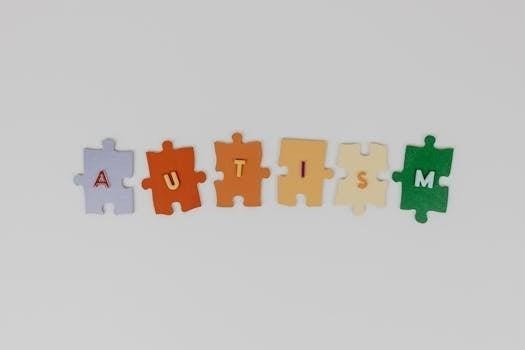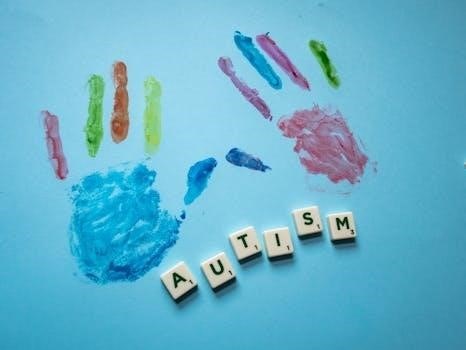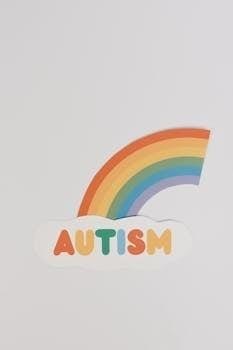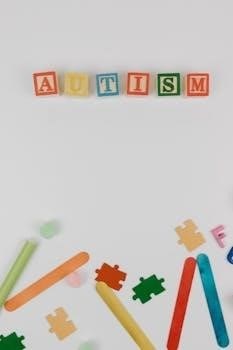The Autism Spectrum Screening Questionnaire (ASSQ) is a tool designed to screen for autism spectrum disorder (ASD), particularly in individuals with high-functioning autism or mild intellectual disabilities․ It aids in identifying potential ASD traits․
Purpose of the ASSQ
The primary purpose of the Autism Spectrum Screening Questionnaire (ASSQ) is to act as a preliminary screening instrument for identifying potential autism spectrum disorder (ASD) traits in children and adolescents, particularly those with high-functioning ASD or mild intellectual disabilities․ It aims to efficiently and practically highlight individuals who may require further, more comprehensive diagnostic assessments․ The ASSQ is not a diagnostic tool but serves as an initial step in the evaluation process, prompting further investigation when necessary․
Development and Authors of the ASSQ
The ASSQ was developed by Ehlers, Gillberg, and Wing, experts in the field of autism; Their collaboration aimed to create a practical tool for identifying ASD traits in children․
Ehlers, Gillberg, and Wing’s Contribution
Ehlers, Gillberg, and Wing, prominent researchers, collaborated to develop the ASSQ․ Their expertise in autism led to the creation of a 27-item questionnaire focused on identifying characteristics of Asperger Syndrome and high-functioning autism․ Their work aimed to provide an efficient method for screening school-aged children, contributing significantly to the early detection of ASD in clinical and educational settings․ Their efforts have greatly impacted the field․

Structure and Content of the ASSQ
The ASSQ consists of 27 questions, focusing on key areas such as social interaction, communication, and behavior․ It is designed to assess the specific traits associated with ASD in children and adolescents․
Number of Questions and Areas Assessed
The Autism Spectrum Screening Questionnaire (ASSQ) comprises 27 items․ These questions are carefully designed to evaluate different facets of behavior and development․ The questionnaire delves into areas such as social interaction skills, communication abilities, and the presence of repetitive or restricted behavioral patterns․ It is intended to provide a broad overview of potential ASD traits by assessing these specific domains․
Focus on Social Interaction, Communication, and Behavior
The Autism Spectrum Screening Questionnaire (ASSQ) places significant emphasis on evaluating key areas affected by autism spectrum disorder (ASD)․ It specifically focuses on aspects of social interaction, examining how individuals engage with others and navigate social situations․ Furthermore, the questionnaire assesses communication skills, both verbal and non-verbal․ Finally, it explores the presence of unusual or repetitive behaviors, which are also core features of ASD․

Target Population for the ASSQ
The Autism Spectrum Screening Questionnaire (ASSQ) is designed for children and adolescents, specifically those aged between 6 and 17 years․ It is suitable for individuals with high-functioning ASD․
Age Range for Administration (6-17 years)
The Autism Spectrum Screening Questionnaire (ASSQ) is specifically designed for use with children and adolescents within the age range of 6 to 17 years․ This particular age group is targeted because the behaviors and characteristics associated with autism spectrum disorder become more apparent during these developmental stages․ The ASSQ aims to identify potential ASD traits in this critical period, aiding in timely intervention and support․
Suitability for Children with High Functioning ASD and Mild Intellectual Disability
The Autism Spectrum Screening Questionnaire (ASSQ) is particularly well-suited for screening children and adolescents with high-functioning autism spectrum disorder (ASD), as well as those with mild intellectual disability․ Its design takes into account the subtle variations in behaviors and social communication that may be present in these populations․ It effectively identifies ASD traits in individuals who may not have significant cognitive impairments, making it a valuable tool for this group․

Administration and Completion of the ASSQ
The Autism Spectrum Screening Questionnaire (ASSQ) is typically completed by parents or teachers who have observed the child or adolescent․ This ensures a comprehensive view of the individual’s behaviors․
Who Completes the Questionnaire (Parents or Teachers)
The Autism Spectrum Screening Questionnaire (ASSQ) is designed to be completed by either parents or teachers․ These individuals are chosen because they typically have the most consistent and comprehensive observations of the child or adolescent’s behavior across various settings․ Their insights provide crucial information about social interaction, communication, and behavioral patterns, which are essential for the screening process․ This approach ensures a well-rounded perspective when assessing for potential ASD traits․
ASSQ as a Screening Tool
The ASSQ serves as a practical screening tool for identifying potential autism spectrum disorder traits in children and adolescents within clinical and educational settings․ It helps indicate the need for further evaluation․
Use in Clinical and Educational Settings
The Autism Spectrum Screening Questionnaire (ASSQ) is employed in both clinical and educational environments to help identify children and adolescents who may exhibit characteristics of autism spectrum disorder․ In clinical settings, it aids clinicians in initial assessments, while in schools, educators use it to recognize students who may need further evaluation․ The ASSQ helps facilitate early detection of ASD, prompting timely interventions and support services for the individual․
Limitations of the ASSQ (Not a Diagnostic Tool)
It is crucial to remember that the Autism Spectrum Screening Questionnaire (ASSQ) is not a diagnostic tool for autism spectrum disorder․ The ASSQ serves as a screening instrument to indicate potential ASD traits, it should not be used to make a formal diagnosis․ A comprehensive evaluation by qualified professionals, is necessary to confirm ASD․ It should be used as a first step towards a full assessment․
Scoring and Interpretation of the ASSQ
A higher score on the ASSQ indicates a greater presence of autistic traits․ A score of 13 or above suggests a higher likelihood of ASD, warranting further assessment by professionals․
Indications of a Positive Screen
A positive screen on the ASSQ, typically indicated by a score of 13 or higher, suggests the presence of significant autistic traits in the individual․ This does not confirm an ASD diagnosis; it merely signals the need for further, more comprehensive evaluation by qualified professionals like neuropsychologists or psychiatrists․ Such a result highlights potential difficulties in social interaction, communication, and behavior, which require careful consideration and further investigation to determine if an ASD diagnosis is appropriate․
Other Screening Tools for ASD
Besides the ASSQ, other tools like the Social Communication Questionnaire (SCQ) and the Modified Checklist for Autism in Toddlers (M-CHAT-R) are used to screen for ASD, each with specific focus areas․
Social Communication Questionnaire (SCQ)
The Social Communication Questionnaire (SCQ) is another screening instrument for autism spectrum disorder (ASD), often used alongside the ASSQ․ The SCQ assesses communication and social interaction skills through a parent-completed questionnaire․ It helps identify potential social communication difficulties․ Unlike the ASSQ, the SCQ may be used for a broader age range․ It is also a valuable tool in identifying individuals who may require further diagnostic evaluation for ASD․
Modified Checklist for Autism in Toddlers (M-CHAT-R)
The Modified Checklist for Autism in Toddlers (M-CHAT-R) is a widely used screening tool specifically designed for very young children, typically toddlers․ This parent-completed questionnaire focuses on identifying early signs of autism․ The M-CHAT-R consists of a brief set of questions about a child’s behavior and development․ It is used to determine if a child needs further assessment for autism․ It is shorter and different in its focus from ASSQ․

Availability and Copyright of the ASSQ
The ASSQ is currently facing availability issues due to copyright restrictions, making it difficult to access․ This limits widespread use of the screening tool despite its established efficacy․
Current Availability Issues
Due to copyright concerns, the Autism Spectrum Screening Questionnaire (ASSQ) is not readily accessible for widespread use․ This limited availability hinders its potential as a valuable tool for early autism detection․ The restrictions impact researchers, clinicians, and educators who seek to utilize the ASSQ for screening purposes․ The challenge highlights the need for accessible and validated screening tools for ASD․ This situation underscores the importance of addressing copyright issues to ensure crucial resources are available․
Additional Information on Autism Spectrum Screening Questionnaires
Other tools, like the Autism Spectrum Quotient (AQ) test, exist for assessing autistic traits in adults․ These questionnaires complement the ASSQ, offering a range of options across different age groups and needs․
Autism Spectrum Quotient (AQ) Test for Adults
The Autism Spectrum Quotient (AQ) Test is a self-administered questionnaire designed to measure autistic traits in adults․ This 50-question test is suitable for individuals with an IQ over 80, and it serves as a self-report measure for possible ASD․ It helps in identifying the expression of autistic traits, aiding in further diagnostic evaluations․ However, it is not a diagnostic tool itself․